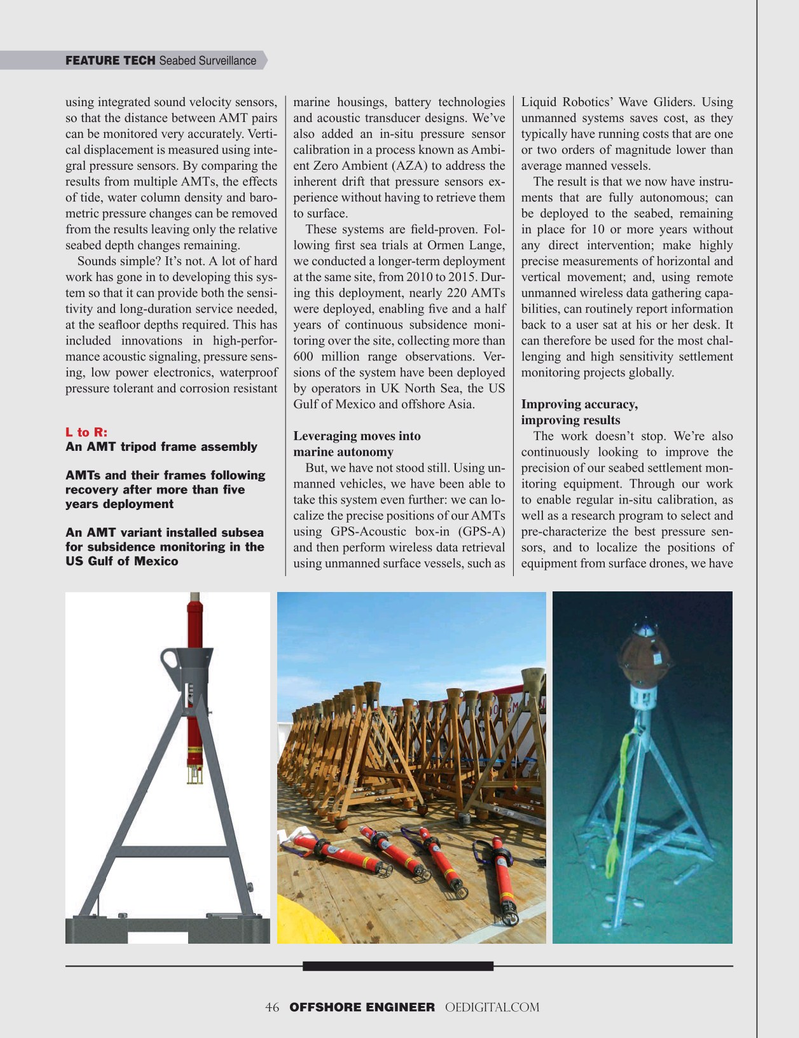
Page 46: of Offshore Engineer Magazine (Mar/Apr 2019)
Deepwater: The Big New Horizon
Read this page in Pdf, Flash or Html5 edition of Mar/Apr 2019 Offshore Engineer Magazine
FEATURE TECH Seabed Surveillance using integrated sound velocity sensors, marine housings, battery technologies Liquid Robotics’ Wave Gliders. Using so that the distance between AMT pairs and acoustic transducer designs. We’ve unmanned systems saves cost, as they can be monitored very accurately. Verti- also added an in-situ pressure sensor typically have running costs that are one cal displacement is measured using inte- calibration in a process known as Ambi- or two orders of magnitude lower than gral pressure sensors. By comparing the ent Zero Ambient (AZA) to address the average manned vessels.
results from multiple AMTs, the effects inherent drift that pressure sensors ex- The result is that we now have instru- of tide, water column density and baro- perience without having to retrieve them ments that are fully autonomous; can metric pressure changes can be removed to surface. be deployed to the seabed, remaining from the results leaving only the relative These systems are ? eld-proven. Fol- in place for 10 or more years without seabed depth changes remaining. lowing ? rst sea trials at Ormen Lange, any direct intervention; make highly
Sounds simple? It’s not. A lot of hard we conducted a longer-term deployment precise measurements of horizontal and work has gone in to developing this sys- at the same site, from 2010 to 2015. Dur- vertical movement; and, using remote tem so that it can provide both the sensi- ing this deployment, nearly 220 AMTs unmanned wireless data gathering capa- tivity and long-duration service needed, were deployed, enabling ? ve and a half bilities, can routinely report information at the sea? oor depths required. This has years of continuous subsidence moni- back to a user sat at his or her desk. It included innovations in high-perfor- toring over the site, collecting more than can therefore be used for the most chal- mance acoustic signaling, pressure sens- 600 million range observations. Ver- lenging and high sensitivity settlement ing, low power electronics, waterproof sions of the system have been deployed monitoring projects globally.
pressure tolerant and corrosion resistant by operators in UK North Sea, the US
Gulf of Mexico and offshore Asia. Improving accuracy, improving results
L to R:
Leveraging moves into The work doesn’t stop. We’re also
An AMT tripod frame assembly marine autonomy continuously looking to improve the
But, we have not stood still. Using un- precision of our seabed settlement mon-
AMTs and their frames following manned vehicles, we have been able to itoring equipment. Through our work recovery after more than ? ve take this system even further: we can lo- to enable regular in-situ calibration, as years deployment calize the precise positions of our AMTs well as a research program to select and using GPS-Acoustic box-in (GPS-A) pre-characterize the best pressure sen-
An AMT variant installed subsea for subsidence monitoring in the and then perform wireless data retrieval sors, and to localize the positions of
US Gulf of Mexico using unmanned surface vessels, such as equipment from surface drones, we have 46 OFFSHORE ENGINEER OEDIGITAL.COM 32-49 OE 2019.indd 46 4/15/2019 10:59:57 AM

 45
45

 47
47